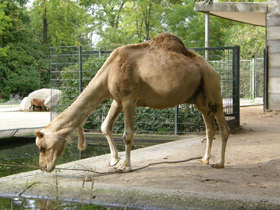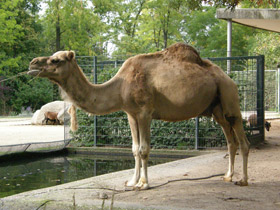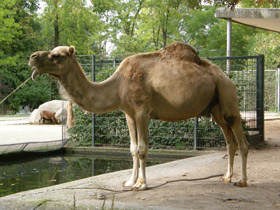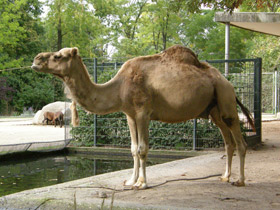The Dromedary or Arabian camel Camelus dromedarius
In the past, wild Arabian camels inhabited deserts of North Africa and Middle East but only domesticated one-humped camels have survived to our days, and they are widely used by humans as animals of burden carrying passengers or cargo. Strange, as it may seem, the only surviving feral herds of dromedary camels numbering from 50 to 100 thousand specimens, are those found in Australia. The name “dromedary” is literal translation from the Greek word for “running”. Many characteristics of this animal indicate that it is related to the two-humped camel: two toes on its feet are sheathed in calloused pads rather than in hooves; it has multi-chambered stomach; and it is able to survive without water for a long time too. However, there are many differences between these two camels: the dromedary has one hump, and is significantly smaller than the two-humped camel (the body length ranges from 2.3 to 3.4 m, height at the shoulders, from 1.8 to 2.3 m, and weight, from 300 to 700 kilograms). The tail in one-humped camel is short, not exceeding 50 cm, the body is slimmer and legs are longer; this camel has long hairs on the neck. As in many other animals living in open habitats, sharp eyesight is most important for the camels, but their sense of smell is also very well developed: the dromedaries are thought to sense smells from the distance of several kilometers. Upper lip of the dromedary is split, its nostrils are slit-shaped and the animals can close them when they need to prevent sand from clogging; their eye lashes are amazingly long and thick and have an interlocking system so that they shut in case of danger; the special thick skin under the soles of the feet, on the knees, and on other body parts is a precaution for the burning desert sand and stones. Special mechanisms help to minimize losses of water from the dromedary body. The coat consisting of thick and matted hairs prevents the animal from extra water loss. The dromedary camel has very few sweat glands and will not start sweating until its body temperature rises to 41 degrees Celsius. Up to five litres of water can be conserved by the camel's ability to fluctuate its body temperature throughout the day, from 34 degrees Celsius in cool desert nights to 41 degrees Celsius in the daytime. The dromedaries carrying cargo can survive without water for one week, and the camels that don’t carry a load or man, up to 20 days, losing body water equal to 40% of their body weight without any harm to their lives. But when the camel gets to water, it can consume up to 130 litres of water in just 10 minutes fully compensating its water loss (and it can drink salty water too!). It is interesting that water is stored in the stomach rather than in the hump, while the hump is storing fat that camel uses as a source of energy. The one-humped camel preserves every drop of its body water; it is able to produce very concentrated urine and loses very little water in its faeces. It is probably better adapted to the dry climate than the Bactrian camel – at least, the dromedary is distributed in more southern areas. The dromedary eats up to 20 kilograms of grasses, twigs and leaves a day spending from 8 to 12 hours per day on foraging. It can even feed on dry or salty plants. The dromedary is able to browse leaves from tree branches at the height of up to 3.5 meters, and occasionally would feed on animals. Moreover, the dromedary would eagerly eat thorny twigs covered with five-centimetre-long thorns. Large, tough lips enable camels to grasp dry and thorny desert vegetation and chew each bite without injuring themselves. Consumed food that is not properly chewed moves to the first stomach where it is fermented to produce cud. This process is similar to what is seen in ruminant even-toed ungulates, but zoologists believe that these two groups of animals evolved independently which idea is supported by the fact that the Camelids have multiple glands in the first stomach. Canine teeth in camels grow throughout life and do not have roots, which is very important for the animals eating hard grains.
Wild dromedaries live in harem groups consisting of one male and 6 to 30 females and their offspring of different ages. In mating season, males fight for the dominance over the female and sometimes their bites kill their competitors. In this period, poll glands on each side of the male’s neck produce copious amounts of strongly smelling secretion that is reputed to attract females, and the male bends its neck back and rubs it against other parts of its body. Gestation in the dromedary females lasts from 360 to 440 days and usually results in the birth of one calf who is able to walk by the end of the first day of life. Camel female’s milk is rich in vitamins, minerals, and proteins, and the female nurses her calf for 7 to 10 months, though the calf usually tries eating plant food from the age of three months. The calves do not completely separate from their mothers until the age of one to two years; young females reach sexual maturity by the age of three years, the males, by 4 to 6 years of age.
Arabian camels have been domesticated for at least 6,000 years. Camels can carry a load weighing up to 300 kilograms, though they usually have to carry about 100 kg, and they can walk up to 40 kilometres a day at the speed of 3.5 km/h (sometimes the dromedary can cover up to 80 km in one day). Domesticated dromedaries are found from Mediterranean areas to Equatorial Africa, Northern India, Greater Caucasus and Middle Asia. Currently, the size of the global population of the one-humped camels is estimated at 17 million specimens, with over 50% of these dromedaries living in Sudan and Somali.



















































